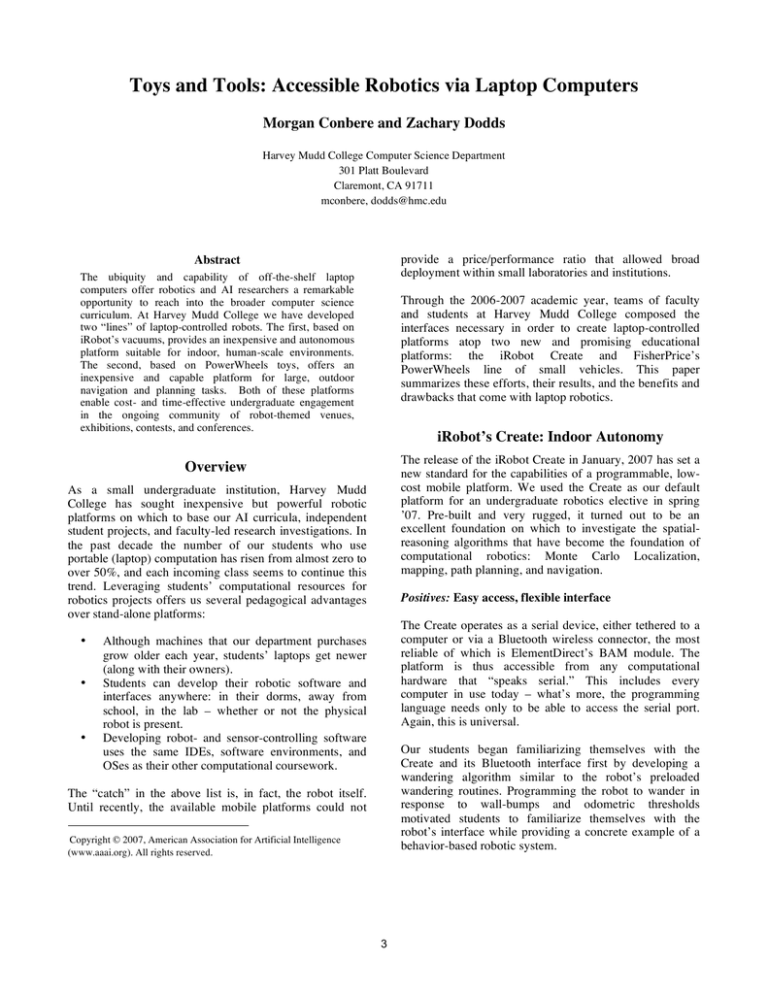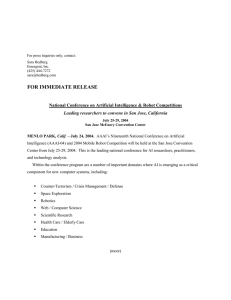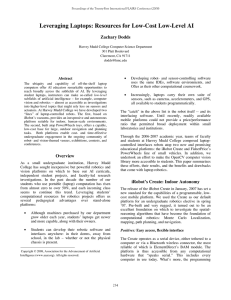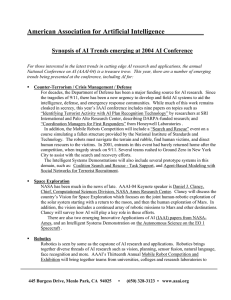
Toys and Tools: Accessible Robotics via Laptop Computers
Morgan Conbere and Zachary Dodds
Harvey Mudd College Computer Science Department
301 Platt Boulevard
Claremont, CA 91711
mconbere, dodds@hmc.edu
provide a price/performance ratio that allowed broad
deployment within small laboratories and institutions.
Abstract
The ubiquity and capability of off-the-shelf laptop
computers offer robotics and AI researchers a remarkable
opportunity to reach into the broader computer science
curriculum. At Harvey Mudd College we have developed
two “lines” of laptop-controlled robots. The first, based on
iRobot’s vacuums, provides an inexpensive and autonomous
platform suitable for indoor, human-scale environments.
The second, based on PowerWheels toys, offers an
inexpensive and capable platform for large, outdoor
navigation and planning tasks. Both of these platforms
enable cost- and time-effective undergraduate engagement
in the ongoing community of robot-themed venues,
exhibitions, contests, and conferences.
Through the 2006-2007 academic year, teams of faculty
and students at Harvey Mudd College composed the
interfaces necessary in order to create laptop-controlled
platforms atop two new and promising educational
platforms: the iRobot Create and FisherPrice’s
PowerWheels line of small vehicles. This paper
summarizes these efforts, their results, and the benefits and
drawbacks that come with laptop robotics.
iRobot’s Create: Indoor Autonomy
The release of the iRobot Create in January, 2007 has set a
new standard for the capabilities of a programmable, lowcost mobile platform. We used the Create as our default
platform for an undergraduate robotics elective in spring
’07. Pre-built and very rugged, it turned out to be an
excellent foundation on which to investigate the spatialreasoning algorithms that have become the foundation of
computational robotics: Monte Carlo Localization,
mapping, path planning, and navigation.
Overview
As a small undergraduate institution, Harvey Mudd
College has sought inexpensive but powerful robotic
platforms on which to base our AI curricula, independent
student projects, and faculty-led research investigations. In
the past decade the number of our students who use
portable (laptop) computation has risen from almost zero to
over 50%, and each incoming class seems to continue this
trend. Leveraging students’ computational resources for
robotics projects offers us several pedagogical advantages
over stand-alone platforms:
•
•
•
Positives: Easy access, flexible interface
The Create operates as a serial device, either tethered to a
computer or via a Bluetooth wireless connector, the most
reliable of which is ElementDirect’s BAM module. The
platform is thus accessible from any computational
hardware that “speaks serial.” This includes every
computer in use today – what’s more, the programming
language needs only to be able to access the serial port.
Again, this is universal.
Although machines that our department purchases
grow older each year, students’ laptops get newer
(along with their owners).
Students can develop their robotic software and
interfaces anywhere: in their dorms, away from
school, in the lab – whether or not the physical
robot is present.
Developing robot- and sensor-controlling software
uses the same IDEs, software environments, and
OSes as their other computational coursework.
Our students began familiarizing themselves with the
Create and its Bluetooth interface first by developing a
wandering algorithm similar to the robot’s preloaded
wandering routines. Programming the robot to wander in
response to wall-bumps and odometric thresholds
motivated students to familiarize themselves with the
robot’s interface while providing a concrete example of a
behavior-based robotic system.
The “catch” in the above list is, in fact, the robot itself.
Until recently, the available mobile platforms could not
Copyright © 2007, American Association for Artificial Intelligence
(www.aaai.org). All rights reserved.
3
Students then implemented Monte Carlo Localization
(Thrun at al., 2001) using the same two sensors – tactile
and odometric – in order to maintain a particle-based
probability distribution over the set of possible poses of the
robot. That the sensing does not suffice to localize
unambiguously, in fact, better conveys the power – as well
as the limitations – of particle filters in comparison with
parametric ones such as the Kalman filter. On platforms
with laser range finders Monte Carlo Localization tends to
converge on the correct location so quickly that the
underlying strengths – and assumptions – of the algorithm
could be taken for granted.
In order to visualize their algorithms’ processing, students
used and improved a compact, Python-based GUI that
plotted the robot’s, the particles’, and the obstacles’ poses
in a global coordinate frame. Built atop the Pyro and, now,
Myro set of Python resources (Blank et al. 2005), this
visualizer provides a convenient interface for students to
debug their localization routines. Figure 1 summarizes one
team’s submission.
Figure 1 Snapshots of the visualizer (left) and the physical
Create (right) during monte carlo localization. The white dot at
left represents the most probable location of the robot, with
darker pose hypotheses indicating lower likelihoods. Note that the
best estimate is very close to the robot's real position, even as the
odometry, shown as the blue dot, veers far from the true path.
Figure 1, shot in the kitchen area of one of our school’s
dormitories, emphasizes how the Create’s accessibility
extends beyond its low price of $150-$200 each with the
power system and charger. Equally important, these robots
are robust enough to be lent out to students during the
semester: four teams brought them back to their rooms in
order to develop there, instead of being tied to the labs on
the academic side of our campus.
Figure 2 (Top left) A Create being controlled by a hamster ball
positioned atop an inverted mouse. The large hamsterball
replaced the mouse’s trackball surprisingly well, and by simply
reading mouse coordinates (all done within Python), it was
possible to create a hamster-controlled vehicle. (Top right)
Another team created a “graffitibot” that would render arbitrary
images in dry-erase marker on the floors of the department.
(Middle) The graffitibot used an off-board vision system and
human-specified waypoints to determine its path. (Bottom) A
third team created convoy behaviors and deployed them on a
series of three Creates using the built-in infrared sensors and
iRobot’s virtual walls as IR emitters. The virtual wall on the
center robot stands on a raised platform in order not to block the
infrared receiver, which is located at the front of the platform.
Nygaard 2007 has a complete description, along with video.
What’s more, the Create’s expandability led to several
more ambitious projects. One pair of student created a
robot whose motion was controlled by a freely spinning
hamster ball; a second team programmed a trio of followthe-leader Creates. A third group built a sketch-drawing
robot, in which an off-board camera provided the
localization accuracy that Create's odometry could not. The
platform could then render human-specified strokes with a
dry-erase marker on the hallway floors of our department.
A small servo motor could deploy and lift the pen.
4
Negatives: local sensing, nonlocal computation
The Create has only local sensing built-in: two bump
sensors, five cliff sensors, wheel encoders for odometry,
and several measuring the system’s electrical state. In our
opinion, this lack of reach into the off-board world stands
as the platform's biggest drawback. The "green box"
offered by iRobot and known as the command module,
provides a very small amount of computational capability,
but does not extend the sensor reach per se beyond the
perimeter of the platform.
Figure 3b Another design, revised from Figure 3a, using a closed
laptop. Three sophomores used this platform as their entry to the
Tapia's robotics competition in October, 2007.
The two most accessible sensing modalities that can
compensate for this limitation are (1) sonar range sensing
and (2) vision. Both require an on-board computer to
collect and process the substantial streams of raw data
involved. Other research groups have shown success in
mounting special-purpose hardware to Creates for this
purpose, e.g., the Gumstix computers advocated by USC's
Interaction Lab (Mataric et al., 2007), the recently released
recipe involving CMU's Qwerk board (Nourbakhsh et al.,
2007), or the compact formfactor that characterizes Brown
University's SMURV platform (Lapping-Carr et al., 2008).
In contrast, we have experimented with approaches that
use existing laptop computers to serve this purpose.
In our experience, this laptop-based approach offers both
plusses and minuses. Its low cost (the laptops already
exist), familiar programming environments, wireless
capabilities, and the resulting ease in adding sensors argue
for placing laptops on board. Yet owners are also rightfully
concerned about entrusting their computer to the fortunes
of a possibly erratically moving vehicle. Also, although
certainly powerful enough, the Create is really too small to
comfortably contain the large desktop-replacement
machines that many people prefer in a portable computer
today. A computer any larger than a small Mac PowerBook
will extend beyond the boundary of the Create, preventing
the bumper from sensing obstacles in at least some
orientations of the platform. Aesthetically, too, we have
reservations about the designs we have tested to date:
overall, they don't "sit well" or "fit well," despite their
advantages for sensor and student accessibility.
Figure 3 depicts two such COTS-laptop designs that we
have publicly demonstrated. The top image shows a Create
which uses vision to autonomously follow its sibling, an
iRobot Roomba Red, as exhibited at AAAI 2007. The
bottom image adds panning sonar sensors to the previous
vision-only system. The robot shown competed at the
Tapia Robotics Competition in Orlando, Florida in
October, 2007.
PowerWheels for outdoor applications
This sense that the Create was too small of a platform to
comfortably support a laptop led us to explore an
alternative scaffolding for accessible robotics: the Fisher
Price PowerWheels toys. Designed for small children,
these plastic vehicles come with a rechargeable battery and
motors that support well over an hour of operation and can
carry 40-50 pounds of external load without difficulty. A
bit large for indoor use, these vehicles are an excellent
option for accessible outdoor robotics. Indeed, our designs
derive directly from Bob Avanzato's work at Penn State
Abington, where an annual Mini Grand Challenge contest
challenges such vehicles to autonomously navigate the
university's campus paths (Avanzato 2007).
To interact with motors and sensors, we have leveraged
pair of well-supported microcontroller boards: the arduino
and the brainstem. The process of altering the vehicle to
run under laptop control requires less than an hour of
student effort and approximately $100 in easily obtainable
parts (Avanzato 2008). Figure four shows two of our
vehicles.
Figure 3a The Create chasing a Roomba Red based on color cues
extracted from an onboard webcamera, exhibited at AAAI 2007
5
As examples of the visual processing that has leveraged
OpenCV, one PowerWheels vehicle was programmed to
approach and follow yellow objects: this successfully
tracked our beachball both indoors and out, but
occasionally got distracted, e.g., by an unusually bright
pair of tennis shoes (Figure 6). Another application took
advantage of the morphological operators OpenCV
implements in order to support subtasks of the Mini Grand
Challenge: finding cones, segmenting road, and mapping
the environment.
Figure 4 Two PowerWheels vehicles, adapted to run
autonomously via an onboard laptop computer. Best suited for
outdoor applications, these vehicles used vision, GPS, and sonar
sensing in order to follow trails and navigate paths on campus.
We briefly consider each subtask here:
To find cones, we first mask the input image using a cone
color filter as described above. Once the image has been
masked, we find connected components of marked pixels.
We then decide that any component that is large enough
must be a cone. This removes noise but does not account
for other cone-colored objects in the image. Once the
connected components representing cones have been
found, we calculate the center and determine that to be the
center of the cone in the image. This position will later be
transformed and placed on our map.
Leveraging OpenCV on Mac OS X
Cameras for laptops are cheap and available sensors, but
without software to interface with these webcams they can
not help our robotics efforts. OpenCV, an open source
computer vision library, provides the low level access to
the hardware as well as providing higher level functionality
in areas such as image processing and object recognition.
Because OpenCV's support for MacOS X was quite
limited, as part of this project we sought to extend
OpenCV to take advantage of the native development
environment and libraries available to all Macs.
Recognizing road by color is made difficult by the fact
that roads are multi-colored and have a great deal of
variation from pixel to pixel. We can account for things
like light and shadow using the clusters in our color
recognizer. To minimize the noise of pixel-to-pixel
variations, we preprocess the image by applying a blur to
the input image. This preprocessed image is then masked
using the color filter. The masked image is then postprocessed by alternately blurring and thresholding the
masked image. This both fills in missing pixels in large
blocks of included pixels and eliminates noise. This image
(called 'Painted image') is then transformed onto the x-z
plane to be passed into our mapping system.
This project began in order to free Open CV's Mac port
from its many external dependencies, e.g. libjpeg,
libtiff, ffmpeg, and several others. Indeed, the
dependency on ffmpeg required a version older than the
current release, which complicated the installation of the
vision library. We succeeded in freeing the system from
those dependencies, relying instead on Mac OS's wealth of
built-in support for image and video formats. In addition, a
make option now allows users to create a Framework
build of OpenCV, Macs' native format for building
software that can be installed via drag-and-drop. The
resulting library retains the wealth of computer vision
algorithms for which OpenCV is known, but now in a
package that helps preserve the sanity of users whose
operating system is Mac OS X. The new system has been
folded into the Sourceforge repository (OpenCV, 2007).
The mapping system can determine the probable location
of road with respect to our robot, given the results of the
above processing steps. Specifically it transforms each
pixel of the masked image down onto the x-y plane and
then stores these values in a map image where each pixel
corresponds with a box in space. Currently the mapping
system simply returns this image so that it can be displayed
as seen below in the top left corner of the screen shot. Note
that this system is limited in so far as the "stretch" of the
masked image produces the striations observed below. We
plan on blurring the map image to eliminate those
striations. Since we use brightness to indicate strength of
knowledge this will result in those portions of the map
simply having less weight.
Figure 6 summarizes these processing steps with a
screenshot of the visual pipeline employed.
Figure 5 Color tracking – and mistracking – using OpenCV.
6
community. We look forward to working with other
educators and researchers to continue to make AI robotics
a welcoming field in which undergraduates can quickly get
up to speed and begin to make contributions. It is this
active engagement within the larger community, we
believe, that provides the most lasting benefit both to new
students and established AI practitioners alike.
Acknowledgments
The authors gratefully acknowledge support from National
Science Foundation DUE CCLI #0411176 and funds
provided by Harvey Mudd College. Steven Wyckoff
(HMC '07) and Mike Roberts (HMC '08) provided the mini
grand challenge subtask descriptions and software.
Figure 6 A screenshot of the OpenCV-based cone- and roadfinding software for our "Gator Jeep" PowerWheels platform.
Color segmentation, morphological operators, region extraction
and convolution are sequenced in order to stay on the path and
away from obstacles (orange road-cones, in this case)
References
Avanzato, R. (2007) Mini Grand Challenge Contest for Robot
Education. In Robots and Robot Venues: Resources for AI
Education, AAAI Technical Report SS-07-09, pp. 7-9, AAAI
Press.
Perspective and Continuing Work
With iRobot's release of the Create and Bob Avanzato's
pioneering work with PowerWheels vehicles, we have
found that the distinction between educational platforms
and research-ready platforms is rapidly fading. In both
cases, the use of commercial, off-the-shelf computation in
the form of students' laptop computers offers considerable
advantages and flexibility:
Avanzato, R. (2008) The Mini Grand Challenge website,
www.ecsel.psu.edu/~avanzato/robots/contests/outdoor/
Blank, D.S., Kumar, D., Meeden, L., and Yanco, H. 2005) The
Pyro toolkit for AI and robotics. AI Magzine. 27(1), pp. 39-50.
IGVC (2008) http://www.igvc.org/
• In each case, the focus is software and computation, not
hardware or assembly. Though we did spend a
considerable time on the PowerWheels hardware, but
with that hard-won experience, future development can
focus on the computational facets of the field.
Lapping-Carr, M., Jenkins, O. C., Hinkle, T., Schwertfeger, J.,
and Grollman, D. Wiimote Interfaces for Lifelong Robot
Learning. In Using AI to Motivate Greater Participation in
Science, AAAI Technical Report SS-08-08, to appear, AAAI
Press
• iRobot's platforms are rugged, familiar, and are suited to
exploration within indoor, human-scale environments.
Mataric, M., Koenig, N., and Feil-Seifer, D. (2007) Materials for
Enabling Hands-On Robotics and STEM Education. In Robots
and Robot Venues: Resources for AI Education, AAAI Technical
Report SS-07-09, pp. 99-102, AAAI Press.
• The PowerWheels platforms are similarly robust, but
extend our students' reach to outdoor environments -- in
particular, to the Mini Grand Challenge at Penn State
Abington or the International Ground Vehicle
Competition in Rochester, Michigan (IGVC, 2008).
Nourbakhsh, I., Hamner, E., Lauwers, T., DiSalvo, C., Bernstein,
D. TeRK: A Flexible Tool for Science and Technology
Education. In Robots and Robot Venues: Resources for AI
Education, AAAI Technical Report SS-07-09, pp. 117-122,
AAAI Press.
• Because they are peripheral to existing laptop
computation, both platforms leverage the sensors and
computation that our department -- and our students -already have.
Nygaard, C., Pflueger, M., and Roberts, K. Multiple Coordinating
Robots, at www.cs.hmc.edu/twiki/bin/view/Main/FinalReport (2007)
• Both systems have low total cost: $250-300 for a wellequipped iRobot system, and $450-500 for an
autonomous PowerWheels platform.
OpenCV (2007) http://sourceforge.net/projects/opencvlibrary/
Thrun, S., Fox, D., Burgard, W. and F. Dellaert, 2001. Robust
Monte Carlo Localization for Mobile Robots, Artificial
Intelligence, 128(1-2): pp. 99-141.
The addition of an accessible version of the powerful
OpenCV vision library for Mac OS X further eases the
learning curve for student involvement with robotics
algorithms, development, and the broader robotics
7






